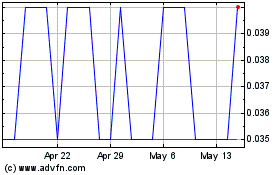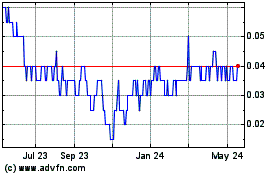Canstar Resources Announces Positive Results on the Mary March Base Metals Project
February 25 2013 - 6:00AM
Marketwired Canada
The directors of Canstar Resources Inc. (Canstar) (TSX VENTURE:ROX), are pleased
to report that Phase One diamond drilling has recently been completed on the
Mary March project located in the Buchans Group volcanic belt, approximately 20
kilometers northeast of the prolific, formerly producing Buchans Mine, in
Central Newfoundland. This property is held via a 50/50% joint venture between
Canstar Resources Inc. and Xstrata Zinc Canada where Canstar is the operator.
All assays have now been received and a compilation report is being prepared
with recommendations for a second round of diamond drilling.
The Mary March/Nancy April system is a large, strong VMS alteration zone
comparable in size, volume and strength to that at Buchans. Eight holes, six on
the Mary March Zone and two on the Nancy April Zone, totaling 2,320 meters, were
completed. Semi-massive or massive sulphides were intersected in four holes -
MM-12-21, MM-12-23, MM-13-27, and MM-13-28.
The tables below provide details of the drilling program including significant
assays.
Hole No: UTM coordinates Azimuth Angle Length
MM-12-21 533,592 E 5,408,481 N 132 46 301
MM-12-22 533,659 E 5,408,585 N 123 49 376
MM-12-23 534,357 E 5,408,931 N 127 45 400
MM-12-24 534,542 E 5,408,838 N 123 54 211
MM-12-25 534,204 E 5,408,446 N 120 65 352
MM-12-26 534,328 E 5,408,602 N 130 71 189
MM-12-27 534,448 E 5,408,733 N 132 44 265
MM-12-28 534,493 E 5,408,782 N 130 60 226
ASSAYS
Hole No From To M Au ppb Ag g/t Cu% Zn% Pb%
Nancy April Zone
MM-12-21 267.8 268 0.2 22 7.5 2.40 -- --
MM-12-22 Minor values only
Mary March Zone
(i)MM-12-23 315.59 316.61 1.02 1258 35.5 0.05 5.20 0.99
325.79 327.09 1.30 823 40.7 0.02 1.89 0.73
MM-12-24 No significant values
MM-12-25 265.62 265.78 0.16 189 90.5 0.50 7.00 3.90
MM-12-26 No significant values
MM-12-27 123.28 123.52 0.24 61 3.9 0.69 3.10 0.06
214.79 216.16 1.37 36 1.0 0.18 1.84 0.23
221.59 221.74 0.15 204 22.1 1.87 12.40 0.42
247.18 249.18 2.00 43 1.4 0.15 2.30 1.40
MM-12-28 199.58 199.86 0.28 197 53.0 0.44 4.70 4.10
(i) MM-12-23 was collared of the same location as previous hole MM-294-07
which intersected 9.33 meters averaging 4.11 g/t Au, 118.10 g/t Ag, 0.66%
Cu, 10.38% Zn, 1.67% Pb.
Nancy April Zone
On the Nancy April horizon, two drill holes, MM-12-21 and MM-12-22, were
completed 220m and 100m respectively, along strike to the southwest from
historic Phelps Dodge drill hole MM-294-16. The first hole of the program,
MM-12-21, intersected 1.6m of massive, fine to medium grained pyrite with low
grade base metals. Both holes successfully intersected the altered and
mineralized Nancy April felsic volcanic panel, but only Hole MM-12-21
intersected the massive pyrite horizon, which occurs just below the top of the
panel. Additionally, the thickness of the Nancy April panel in Hole MM-12-21 is
80m whereas in Hole MM-12-22 it has thinned to 43m (44.6m in MM-294-16) and is
intruded by voluminous altered (diabase) dykes, indicating an improvement to the
southwest in this area.
Mary March Zone
Hole MM-12-23 was designed to twin the Phelps Dodge Discovery Hole MM-294-7,
which had intersected high grade massive sulphides over 9.63m with an average
grade of 10.1% Zn, 1.68% Pb, 0.64% Cu, 122.1 g/T Ag and 4.2 g/T Au. The hole was
collared about one meter from the drill casing of MM-294-7 and was drilled at
the same azimuth and inclination. When the Mary March horizon was encountered,
downhole surveys indicated the hole had wandered approximately 40m northeast of
the MM-294-7 high grade intersection. The geology of MM-12-23 is similar to
MM-294-7 above the massive sulphides; but instead of duplicating the results,
MM-12-23 intersected a lower grade interval of pyritic massive sulphide over
3.15m averaging 2.24% Zn, 0.48% Pb, 0.04% Cu, 21.02 g/T Ag,0.80 g/T Au. Below
the massive sulphides, from 317.85m-341.16m, the Mary March Panel was intruded
by numerous late dykes that separate several additional "screens" of strongly
sericitic felsic volcanic containing low grade semi-massive pyrite. In every
case, the "screens" of semi-massive sulphide is bounded at the upper and basal
contacts by faults. Altered felsic volcanics with semi-massive sulphide zones
occur at: a) 318.18-318.53m; b) 320.66-321.10m; c) 324.42-327.09m; and d)
331.8-341.16m.
Five exploration holes were located up dip from the Phelps Dodge Discovery Hole
MM-294-7 and along strike for 500m to the southwest. Drill hole MM-12-25, a 500m
step-out, was collared in the footwall below the Mary March horizon, in strongly
altered felsic volcanics. All other holes (MM-12-24, MM-13-26, MM-13-27,
MM-13-28) were collared in the hanging wall and intersected the Mary March
horizon. In several cases, the high grade massive sulphide, was occluded by a
later mafic (diabase gabbro) intrusion.
Hole MM-12-27 was drilled to test the Mary March Panel up-dip from hole
MM-294-10 and included a mineralized interval of 19.40m averaging 0.82% Zn,
0.12% Pb, 0.08% Cu. Hole MM-13-28 intersected 6.1m of massive pyrite, up-dip of
the high grade intersection in the original Discovery Hole.
The high grade intersection originally found in Discovery Hole MM-294-7 and the
preliminary results from Canstar's program on the Mary March and Nancy April
Zones are very similar to several satellite zones encountered at Buchans, which
were indicative of a strong VMS alteration system and proximal to main ore
lenses.
Harry Hodge, Chairman of Canstar Resources, commented, "After more than ten
years since the discovery of the original high-grade intersection by Phelps
Dodge, Canstar's first phase of exploration on the Mary March Project has been
completed and has provided some very encouraging results. Still at the grass
roots stage, the Mary March and Nancy April Zones represent a very complex
geological system that has the potential to yield potentially economic base
metal mineralization. The Company believes that additional comprehensive,
systematic exploration programs are warranted for the property and will announce
Second Phase exploration plans as soon as they are completed."
Mr. Harry J. Hodge, P.Eng., Chairman and a director of Canstar, is a "Qualified
Person" under National Instrument 43-101 and he has reviewed the technical
disclosure in this press release.
On behalf of the board,
Harry J. Hodge, P.Eng., Chairman
Forward-Looking Statements
This News Release includes certain "forward-looking statements". These
statements are based on information currently available to the Company and the
Company provides no assurance that actual results will meet management's
expectations. Forward-looking statements include estimates and statements that
describe the Company's future plans, objectives or goals, including words to the
effect that the Company or management expects a stated condition or result to
occur. Forward-looking statements may be identified by such terms as "believes",
"anticipates", "expects", "estimates", "may", "could", "would", "will", or
"plan". Since forward-looking statements are based on assumptions and address
future events and conditions, by their very nature they involve inherent risks
and uncertainties. Actual results relating to, among other things, results of
exploration, project development, reclamation and capital costs of the Company's
mineral properties, and the Company's financial condition and prospects, could
differ materially from those currently anticipated in such statements for many
reasons such as: changes in general economic conditions and conditions in the
financial markets; changes in demand and prices for minerals; litigation,
legislative, environmental and other judicial, regulatory, political and
competitive developments; technological and operational difficulties encountered
in connection with the activities of the Company; and other matters discussed in
this news release. This list is not exhaustive of the factors that may affect
any of the Company's forward-looking statements. These and other factors should
be considered carefully and readers should not place undue reliance on the
Company's forward-looking statements. The Company does not undertake to update
any forward-looking statement that may be made from time to time by the Company
or on its behalf, except in accordance with applicable securities laws.
FOR FURTHER INFORMATION PLEASE CONTACT:
Canstar Resources Inc.
Harry J. Hodge, P. Eng.
Chairman
416-363-4376
hjhodge@geocanex.com
Canstar Resources Inc.
Karen Willoughby
Manager, Corporate Affairs
1-866-936-6766
kwilloughby@canstarresources.com
www.canstarresources.com
Canstar Resources (TSXV:ROX)
Historical Stock Chart
From May 2024 to Jun 2024

Canstar Resources (TSXV:ROX)
Historical Stock Chart
From Jun 2023 to Jun 2024
